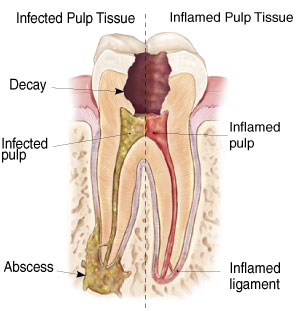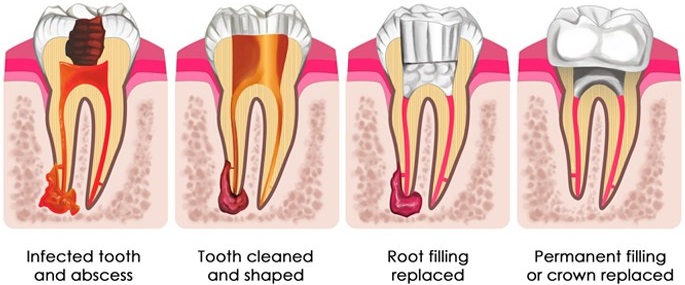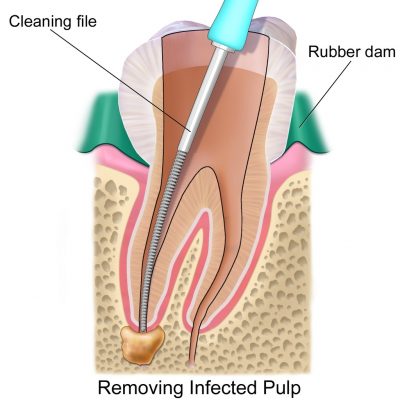When the nerve of your tooth becomes infected, a successful root canal treatment lets you keep the tooth rather than having to pull it out. Keeping your tooth helps to prevent your other teeth from drifting out of line and causing jaw problems. Saving a natural tooth avoids having to replace it with an artificial tooth.
WHAT IS ROOT CANAL TREATMENT?
Root canal treatment is a dental procedure to treat infection at the centre of a tooth (the root canal system). Root canal treatment is also called endodontic treatment.
The infection is caused by bacteria that live in the mouth and invade the tooth when:
- • tooth decay occurs
- • fillings leak, or;
- • teeth are damaged by trauma, such as a fall
When bacteria (germs) enter your tooth through deep cavities, cracks or flawed fillings, your tooth can become abscessed. An abscessed tooth is a tooth with an infection in the pulp. If pulp becomes infected, it needs to be removed. An abscessed tooth may cause pain and/or swelling. Your dentist may notice the infection from a dental x-ray or from other changes with the tooth. If left untreated, an abscessed tooth can cause serious oral health problems
TOOTH STRUCTURE
A tooth is made up of two parts:
- • The crown is the part of the tooth that is visible in the mouth.
- • The root extends into the bone of the jaw, anchoring the tooth in position.
These are composed of the following structures:
- • Enamel is the hard outer coating of a tooth.
- • Dentine is a softer material that supports the enamel and forms most of the tooth.
- • Cementum is a hard material that coats the root surface.
- • Dental pulp is the soft tissue at the centre of the tooth.
The root canal system contains the dental pulp and extends from the crown of the tooth to the end of the root. A single tooth can have more than one root canal.
SYMPTOMS OF A PULP INFECTION

The symptoms of a pulp infection include:
- • pain when eating or drinking hot or cold food and drink
- • pain when biting or chewing
- • the tooth may become loose
As the infection progresses, these symptoms often disappear as the pulp dies. Your tooth then appears to have healed, but in fact the infection is spreading through the root canal system. Eventually further symptoms occur, such as:
- • pain when biting or chewing
- • swelling of the gum near the affected tooth
- • pus oozing from the affected tooth
- • facial swelling
- • the tooth becoming darker in color
It is important that you see your dentist if you develop toothache.
TOOTH RESTORATION AFTER ROOT CANAL TREATMENT
After a root canal treatment, your tooth has to be restored(fixed) to look, feel and work as much like a natural tooth as possible. If an endodontist performed your root canal treatment, he or she will fill the opening of the tooth with a temporary filling and send you back to your dentist or prosthodontist for tooth restoration. A prosthodontist is a dental specialist who restores and replaces teeth using crowns, bridges, dentures and implants. Dr. Tran may use a permanent filling, or a dental crown, a dental bridge, or a dental implant to restore your tooth. The choice of restoration will depend on the strength of the part of the tooth that’s left. A back tooth will likely need a crown because chewing puts a great deal of force on back teeth. If there is not enough of the tooth left, posts may be used to help support the crown.
ROOT CANAL TREATMENT PROCEDURES

When you realize the need for root canal , you need to consult Dr. Tran, dentist in Menifee (Sun City). A series of follow-up visits can be needed for the following:

- • X-ray – The first step would be examination of the decayed site done by carrying out an X-ray. This will show up the site of decay that needs treatment.
- • Anesthesia– Once the site of decay is found, local anaesthesia is provided to the infected tooth.
- • Pulpectomy – In order to remove the decayed site, an opening is made.
- • Filling and Sealing – The opened tooth then is filled with gutta-percha material once the damaged pulp is removed. It is later on sealed off and restored.
AFTER CARE
Following your root canal treatment, you need to give proper care to the restored tooth. Some of the ways of caring for the tooth are:
- • Practising good oral hygiene: Brush your teeth twice a day and don’t forget to floss. Care for your restored tooth to avoid future problems.
- • Visiting the dentist: After getting root canal in Newmarket, don’t forget to make regular visits to the dentist for examinations and cleanups.
- • Not Chewing on hard foods: You must not chew on hard foods that can harm root canals.
- • When the nerve of your tooth becomes infected, a successful root canal treatment lets you keep the tooth rather than having to pull it out. Keeping your tooth helps to prevent your other teeth from drifting out of line and causing jaw problems. Saving a natural tooth avoids having to replace it with an artificial tooth.
